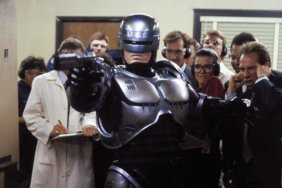If you were like me as a kid, then you also took a good deal of time browsing in the video store, mostly through the “Comedies” section, carefully looking for the feature films that had no half-naked women on the cover, but that were indeed rated R. You see, if there were no nude women on the cover, your parents would rent them for you, but if it was rated R, then you knew you’d get at least a pair of bare breasts or two. The ratings were always a good gauge for the film’s content. Thanks to this method, an entire generation of adolescent boys were able to see sexy films like Ski School, Revenge of the Nerds, and even Police Academy without their parents (necessarily) knowing that they were getting some smut out of the deal.
Indeed, the idea of a R rating was such a firmly ensconced idea in my youth, that it never crossed my mind to think of its origin. The MPAA’s rating system seemed eternal to me, and seemed that it was invented, organically and naturally, right at cinema’s inception. It wasn’t until I, as a teenager, started coming across unrated films (either from other countries, with small budgets, or simply old enough), that I began to think twice. Where did this whole letter-rating system come from?

Let me, if I may, cast your mind back to 1930. In 1930, sound in films was still a novelty (Alan Crosland’s famous film The Jazz Singer was released in 1927 and swept the nation, causing studios to jump on the “talkie” bandwagon). As a result, the popularity of film began to skyrocket to new heights, and people of all ages began flooding to theaters to see whatever the exhibitors were showing. Kids, especially, started turning up in theaters in unprecedented numbers. Thanks to sound, and popularity, and also the generally bawdy attitudes of the Roaring ’20s, films started to, simultaneously, become raunchier. There were sex jokes, adult talk, and even, in rare instances, bare breasts. And while most audiences ate this up, there were, as there are today, a small cadre of outraged citizens who felt that Hollywood was going to far and eroding the morals of our children. See? Outrage at Hollywood didn’t begin with the righteous whining of Michael Medved in the 1980s. It started with Martin Quigley and Fr. Daniel Lord, who wrote a letter to a man named Will H. Hays, the chief censor in Hollywood.
Thanks to this outraged letter, Hays wrote a book on the “acceptability” of a film’s content, which was called, rather ungainly, A Code to Govern the Making of Motion and Talking Pictures. I haven’t been able to find any information about prevailing attitudes towards sexual content in films in 1930, but we do still have some of the rare “pre-Code” films on DVD these days, and we can see that they were a lot smuttier than we typically give films of the era credit for; they weren’t all squeaky-clean musicals. So we can glean that there was a shift in attitudes, from permissive to prudish, as well as political pressure to rein in the insanity. Whether there was a high demand from audiences, filmmakers, incensed parents or studios, the Hollywood Code, nicknamed The Hays Code, was in full implementation by 1934. Films from the era bear a certificate of approval, essentially announcing that the film was appropriate for all audiences.
The Hays Code, it is often viewed, was a form of institutionalized censorship of course. And while the pre-Code films rarely dealt with serious adult issues such as sexuality and violence, they were still much freer to explore whatever kind of joyously smutty material they pleased. Who is to say how film would have evolved, were it left unchecked. Films began to eschew their sexual content to achieve the coveted Certificate, causing some necessary creativity, but an unfortunate reputation for obfuscation and squareness. Would films have been matured more quickly? Or would they have overstuffed themselves and ultimately hurt the industry? It’s a fun “alternate reality” question to ponder. It’s been said by some film scholars that, thanks to the omission of sex, Hollywood had to sexualize other things to get the point across. As a result, smoking cigarettes in films saw a severe uptick. Cigarettes became sexy, smoking rates increased in America, and, to this day, the cigarette industry is thriving largely as a result.

The Hays Code was actually in place as late as 1968. By then, films were used to the pattern of what was okay for them, and what was okay for TV, and just how much studios could get away with in terms of sex, violence and curse words. The F-word was not used in a major motion picture until 1970, in Robert Altman’s M*A*S*H.
In 1966, the Motion Picture Association of America (or MPAA), a close-knit organization of film archivists, maintainers, and moguls, welcomed as its president a man named Jack Valenti (1921-2007), who was probably the best-known and most charismatic president of the organization. Valenti is an invaluable person in film’s history, whose presence in Hollywood has been hotly debated for decades. Depending on whom you ask, he is either a hero for keeping the spirit of film alive or a horrific arbitrary critic who professionally squelched the creative purity of hundreds of cinematic auteurs.

By 1968, despite the outmoded and no-longer-respected Hays Code, some controversial films started to creep into the public consciousness. Who’s Afraid of Virginia Woolf? was especially a bugaboo, as it contained open and rancorous talk about sexual matters, infidelity, and even contained a lot of unexpected nudity. In response to such films, Valenti proposed the MPAA Rating System, wherein films would be judged by their content and given a corresponding letter to indicate just how appropriate it is for kids. The system is still in place today. The ratings went as follows: G (for General audiences), M (for slightly more Mature audiences), R (for restricted audiences), and X (for adult audiences). The differentiation between who is “restricted” and who is “mature,” though, was a little hazy, and a few years later, the system was reclassified as G, PG, R, and X. It was like this all the way through 1984.
Now we’re getting into our lifetimes, I’m guessing, and I’d like to bring up two movies, Tobe Hooper’s Poltergeist and Stephen Spielberg’s Indiana Jones and Temple of Doom, which you no doubt saw as a child, and no doubt were traumatized by. I myself had a good long series of intense nightmares inspired by the killer clown in Poltergeist, and it’s hard to shake the image of Mola Ram reaching into the guy’s chest and pulling his heart out in Temple of Doom. Both of these films were rated PG. The uproar of these films caused the MPAA to rethink things, considering that there may be a pertinent gap between what’s okay for a 10-year-old and what’s okay for a 17-year-old (which was the cutoff age for R-rated films). Hence, the invention of the PG-13 rating.

And yes, even in 1984, there was still an MPAA-sanctioned X rating for films. When I use the phrase “X-rated,” most people immediately think of hardcore pornography. Thanks to some snarky re-purposing on the parts of marketing-savvy pornographers, a lot of hardcore sex films throughout the ’60s, ’70s, and ’80s were declared to be “Rated X,”even though they clearly weren’t submitted for approval. The pornographers wanted to assure customers that their films contained a certain specific content, and the rating quickly lost all its credibility. Even though there were some truly great films to be rated X (among them Last Tango in Paris, A Clockwork Orange, and the Academy Award-winning Midnight Cowboy), the X-rating was soon consigned to the porn ghetto (subsequently, certain porn films decided to up the ante, and some films started being advertised as being “Rated XXX,”or “Triple-X,”a term that is still in use today).
Despite this, the MPAA didn’t stop using the X rating until as late as 1990. The last film to be given an X rating was Leatherface: The Texas Chainsaw Massacre III. And so the X rating sauntered into the night. Harsher films from the era began escaping the restrictive system, and art films like The Cook, the Thief, His Wife, and Her Lover began cropping up and achieving modest success outside of the MPAA system. As a result, the MPAA tried to invent a viable adult rating that wasn’t associated with porn, and they came up with the NC-17 rating.

It should, perhaps, be noted at this point that there is no government regulation of the ratings system, and there is no legal obligation to submit your film to the MPAA for rating. What there is, as with the Hays Code, is a prevailing cultural pressure to receive approval. Indeed, what letter rating your film gets can dictate its distribution level, and, these days, where it can be shown on home video. Big-box retailers like Wal-Mart, for instance, refuse to stock any film rated NC-17. Movie theaters are ultimately the ones who enforce the ratings, and while, again, there is no legality in place that compels theaters to enforce any ratings, they can be taken to civil court if little 9-year-old LaShawn somehow sneaks into Natural Born Killers. What’s more, a “lower” rating on your film can scare off the much-coveted teenage audience, who are likely in the market for something harder. Would you have been so eager to see something like The Dark Knight if you had heard that it was rated PG?
Despite constant claims that what they offer is a codified parental guide, and not censorship in the least, the overall effect of the ratings system has shaped the content of films in a way that resembles censorship. Prevailing attitudes toward the ubiquitous (and unlikely to be abandoned) system immediately affects the way we look at certain movies. If we hear of a spooky horror film, but learn its rated PG, we’ll be less excited. If we hear about a new film that received the rarely-used NC-17 rating, we’ll be drawn or repulsed accordingly. If the latest action blockbuster was not rated PG-13, we might begin to question what’s wrong with it.

There’s an irony to the rating system as well. A film may have piles of blood and gore, hence receiving an R rating, but will not necessarily be interesting to adults. Do you think the mean age of audience members for something like, say, the R-rated Jason X, was over the required 17? On the flip side, this year’s The Tree of Life was rated PG-13, but would be horrifyingly dull for any 13-year-old taken to see it. Roger Ebert once suggested that an “A” rating be instated for films that contained adult content, but were artistically more interesting to grown-ups. But that’s a slippery slope: how long before you’re putting institutionalized ratings on a film’s quality? That’s the job of unassociated critics.
I realize that this week’s lesson has devolved into an editorial, but this is an important and ever-present controversy in the film world. As a critic, I often expound endlessly on an auteur’s right to film what stories they like, and the power of adult stories, but this all must be viewed through a filter of content approval. The filter can, as I have said, force filmmakers to get more creative with their edgy content, and can result in some brilliant filmmaking. But, for the most part, many are frustrated by the ratings and codes that have been in place for over 80 years.
Is a codified rating system something we need? Perhaps. It seems to work… Most of the time.
HOMEWORK FOR THE WEEK: Rent Kirby Dick’s flip and crass documentary film This Film is Not Yet Rated, which talks about the secrecy involved in the shadowy ratings board, and the ultimate impact a rating can have on a movie’s success. It’s not incredibly deep (it never questions the need for a rating system), but it does raise questions. If you can find one, watch a pre-Code movie (they come in easily-found DVD box sets these days; I recommend 1931’s Night Nurse). How does the bawdy content compare to a raunchy film made today? Consider how a rating makes you feel about a movie. Imagine that a film you’re looking forward to has a different rating… How will that change your view? Watch a recent NC-17-rated film, too (if your parents will let you, if necessary). Try Pedro Almodóvar’s Bad Education, or Gregg Araki’s Mysterious Skin. Or one of my favorites, Showgirls. How is sex treated in those films? Is it exploitation, or is it adult? What would you have rated them? Would your rating be any different if you did (or didn’t) have children?








